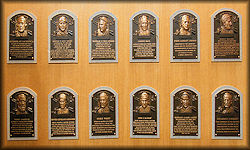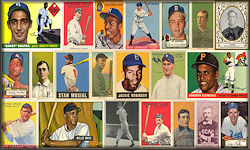Pat Gillick’s election to the Hall of Fame was a triumph for the men and women who spend their careers behind the scenes building teams. And with his election, Gillick joins a very exclusive club within the ranks of Hall of Famers.
Before Gillick, the last pure executive inducted into the Hall of Fame was George Weiss, best known as Casey Stengel’s general manager on the Yankees and the Mets. Weiss was elected in 1971, five years after his retirement from the game and a year before his death
Weiss, a native of New Haven, Conn., and a product of Yale University, got into baseball in 1914 with a semipro team in his hometown that used to play exhibitions against Major League teams, luring the likes of Ty Cobb and Babe Ruth to his small ballpark.
In 1919 he entered organized baseball by acquiring the Eastern League’s New Haven franchise. Four years later, fate intervened. He was in the upper berth of a Pullman car en route to the Winter Meetings, with his manager, Wild Bill Donovan, in the lower berth. It was against protocol; the “boss” should have had the lower. But Donovan was already asleep when Weiss arrived, so he climbed into the upper.
A horrific train wreck near Forsyth, N.Y., claimed Donovan’s life and eight others, but not Weiss’. He would forever live knowing that somehow, it could have been him.
After running the Baltimore Orioles (International League), Weiss was hired by the Yankees in 1932 to develop a farm system, in the style of Branch Rickey’s Cardinals operation. He served under Col. Jacob Ruppert and Ed Barrow in that capacity for 15 years, helping to feed the roster with thoughtful signings and minor league development throughout the Joe McCarthy era.
In 1945, the team was sold to Dan Topping, Del Webb and Larry MacPhail. Two years later, in the celebratory party following the 1947 World Series, known forever after as the “Battle of the Biltmore”, MacPhail wound up firing Weiss.
The next day, Topping and Webb bought out MacPhail’s interest and “rehired” Weiss as general manager. A year later, Weiss brought Casey Stengel to New York to manage the Yankees. The two of them went back to Eastern League days, when Stengel had embarked on his managing career at Worcester, Mass.
Together, the Weiss-Stengel team was close to unbeatable for a dozen years, winning 10 pennants and seven world championships in the post-war, pre-expansion era of baseball. While the teams were laden with great stars, (Mickey Mantle, Whitey Ford and Yogi Berra among them), Weiss was a distant presence, preferring to run the club without much personal contact with the players.
“I don’t think I ever met him,” said Bobby Richardson, who joined the team in 1955. Weiss usually negotiated with just the top three or four players on the roster, and left the balance to Roy Hamey, his assistant.
When Stengel was dismissed after the 1960 World Series, Weiss was offered a consultant’s role, but he soon left to join Stengel and build the expansion New York Mets. Here, the pairing was still friendly, but on different tracks. While Stengel won over the press by diverting attention from his under-performing teams, Weiss worried, dealt, and continued to do what he did best – work hard to build a winner. Three years after his retirement, the Mets won the World Series, with a number of players signed on his watch taking the team to unimaginable heights.
If memories of the early Mets bring a smile to fans’ faces, Weiss was not in on the joke. Enjoying the Marv Thronberry days would have gone against everything he’d ever practiced. And when all was said and done, his 19 Yankee pennant winners were a far better indicator of who George Weiss was. (Ref: National Baseball Hall of Fame) |





